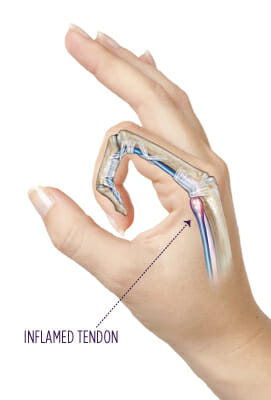
What is Trigger Finger?
Trigger finger occurs when swelling or irritation in a tendon or tendon sheath makes it difficult for you to straighten your finger. When you bend your finger, a flexible cord-like tendon slides through a narrow tunnel called a tendon sheath. Inflammation of the tendon or thickening of the tendon sheath can make it difficult for the tendon to glide through the tunnel, causing the finger to bend and get stuck in a bent position. When this happens in your thumb, it’s called trigger thumb.
Over 200,000 people in the U.S. are affected by trigger finger each year. It can also occur in children, but this is rare.
If you’re in the Minneapolis/St. Paul area, orthopedic specialists at Summit Orthopedics can diagnose and treat your trigger finger.
Symptoms of Trigger Thumb and Finger
Trigger finger and trigger thumb cause symptoms you may be able to see and feel. They include:
- A bump in the palm at the base of the affected finger
- Discomfort and tenderness at the base of the fingers or thumb
- Feeling a catching or snapping sensation when you extend your finger from a flexed position
- Finger locking in a flexed position
- Finger pain
What Causes Trigger Finger?
Doctors cannot always identify the cause of trigger finger. However, several situations can cause trigger finger, from repetitive motions to certain health conditions.
The most common causes include:
- Diabetes: The link between diabetes and trigger finger is not completely understood, but people with diabetes have a higher risk of developing the condition.
- Gout: In this condition, crystal deposits accumulate in the joints and soft tissues. If these deposits occur in the finger, this can increase your risk of trigger finger.
- Repetitive movements: Moving your finger in the same way repeatedly can increase the risk of swelling and irritation.
- Rheumatoid arthritis: This chronic condition causes joint inflammation and irritation and makes you more prone to trigger finger.
- Thyroid disease: Issues with thyroid hormone production can affect tendon health, leading to trigger finger.
Diagnosing Trigger Finger
Your orthopedic expert can diagnose trigger finger with a physical exam. They’ll assess how your finger looks and functions. Ultrasound imaging can also give your doctor a better image of the extent of the inflammation and any other issues in your hand. An ultrasound is a painless, noninvasive imaging test that shows a real-time image of your internal body structures and functions.
Treating Trigger Finger
Treatment for trigger finger can include surgery and nonsurgical methods, such as splinting. Most cases of trigger finger resolve without surgery.
Splinting
A finger splint keeps your finger from moving to reduce swelling. A finger splint for trigger finger uses a sheath device to keep the finger in a straight position.
You can find these devices at pharmacies, but it’s best for a hand expert to fit your finger for a splint.
Your doctor may recommend keeping the splint on for several weeks until it can function normally.
Steroid Injections
You may need steroid injections to relieve the inflammation that’s causing your finger to bend and get stuck. A provider injects the steroid into your finger to treat the swelling.
The number of injections you receive depends on how well you respond to this type of treatment. If the first injection doesn’t provide relief, your doctor may recommend a second shot after four to six weeks. However, if the second injection also fails to improve your symptoms, your doctor may not recommend further steroid injections.
Surgery
Trigger finger surgery, also called trigger finger release, may be necessary for cases of trigger finger that don’t resolve with splinting and steroid injections. Your doctor may also recommend surgery if you have diabetes, as steroid injections can increase blood sugar levels.
During the procedure, your orthopedic surgeon releases the tendon responsible for blocking tendon movement.
Trigger finger release surgery is usually an outpatient procedure, meaning you can return home the same day of treatment.
Can Trigger Finger Be Cured Naturally?
Some cases of trigger finger do not require medical treatments like steroid injections or surgery. Your treatment depends on the severity of your injury. You may be able to fix your trigger finger with stretching exercises.
Light stretching of your finger can help release stiffness and improve function of your finger. You can do this by flexing your affected finger or by using your other hand to pull your injured finger gently.
Get the Highest Level of Care for Trigger Finger
If you have trigger finger, you probably have issues carrying out daily functions, like doing housework, driving and engaging with your favorite activities. Summit’s experienced orthopedic experts are trained in diagnosing and treating conditions that affect hand anatomy, including trigger finger.
Our goal is to diagnose your condition and develop a personalized treatment plan that restores your hand functioning. If you experience an injury or uncomfortable symptoms, our fellowship-trained hand and wrist surgeons are here to help.
Find your Summit Orthopedics hand care expert, request an appointment or call us at (651) 968-5201 to schedule a consultation.
